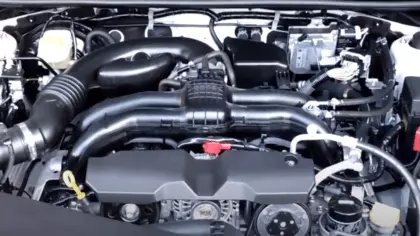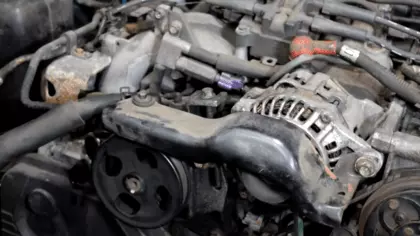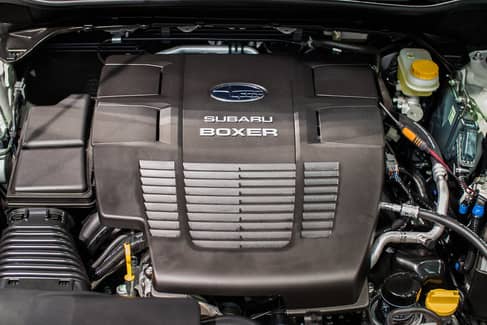Let’s face it; Subaru engine swaps are never an easy process as they might appear to someone. In fact, replacing any Subaru car’s engine is one of the most challenging assignments that a technician will ever do.
In addition, Subaru engine replacement necessitates distinct strategies depending on the year, manufacture, and model.
Hence, it’s critical to consult a service handbook specifically for a car when embarking on a significant project like this.
There may be differences in the process from one car to another, but many aspects of an engine swap are the same no matter what vehicle a user has.
Subaru Engine Swaps: The Complete Procedure

Not all swaps are compatible with all car models. The horsepower and torque of some Subaru engines were explicitly calculated.
The inline four-cylinder engine in the Mazda Miata makes 155 horsepower and 148 pound-feet of torque.
A car will run more smoothly if a user knows which vehicles and engines go well together. 54.2 percent of new car engines sold in 2016 had four cylinders, according to Experian.
Six-cylinder engines’ proportion in the market dropped from 32.5 percent in 2012 to 29.7 percent in 2013. However, Eight-cylinder engines have seen a decline in market share in recent years.
When preparing for an engine change, pay attention to small things like adequate cooling systems, throttle linkages, and working fuel delivery.
In the long run, this can have a significant impact.
1. Make a Comprehensive Plan
It’s difficult to overstate the importance of this. Consider the potential outcomes of various vehicle-engine combinations in the future.
Therefore, it’s also a good idea to start an engine swap with a complete vehicle because some parts can be hard to come by even if a user searches online.
2. Hood Removal
A Subaru engine from a car isn’t likely one of those chores that can be done under a hood still in place.
For example, if someone uses a cherry picker or engine hoist to remove the engine from the engine bay, the hood could get in the way and make accessing connections or bolts difficult.
Hinges with two or three bolts on either side will hold the hood in place.
As one separates the bolts holding the hood to the hinges, they should take the help of a friend to help them lift the hood.
Then, remove the bolts from the vehicle’s bonnet and lift them off using a jack.
3. Find the Engine and Chassis That Go Together
Drawing a dyno graph displaying the speed and horsepower of two different engines can help assure a good fit (in RPM times 1000).
Some engines are mild-mannered enough that no modifications to the driveline are required to keep the power under control and the tires firmly planted.
4. Double-check the Measurements before Cutting Anything
When removing the OEM engine mounts, a reciprocating saw comes in handy. Using a wheel and grinder, it will be as if the mounts never existed in the first place.
5. Making Room
One should make sure they have enough space to perform an engine replacement if necessary. Crossmembers can aid in this step. Whenever you need assistance, don’t be afraid to ask for it.
6. Try it on and See If It Fits
Test-fitting is commonly advised to have a half-inch gap between the oil pan and cross member. One may also use a tiny piece of wood to support the engine (one option worth trying is plywood).
7. Centre the Engine to Fit It
One can help locate the engine’s exact location by using a string to draw a line down the centerline of the vehicle’s undercarriage.
If the engine is not crooked, it can be placed slightly off-center. The U-joints on the driveshaft must be parallel to one another for proper operation.
8. Make Sure the Engine is at the Proper RPM
When it comes to leveling a car, shimming it can help. The idea is to treat the engine and the transmission in the same manner.
The final two slopes should ideally be roughly 3 degrees from front to rear.
9. Position the Engine Low on the Chassis and Far from the Front
The precaution of ensuring proper weight distribution can be helped by positioning the engine far back and low.
One should also make an effort to keep the shifter in the same area and avoid removing the heater shelf that holds the heating unit up.
Related Subaru engine: Subaru 2.4 turbo engine problems
Subaru Engine: Types & Variations
Developed by Subaru, the Subaru engine series is a class of four-stroke internal combustion engines.
Subaru’s engine lineup has spanned decades, with everything from the original E Series, which debuted in the United States long back, to the modern and completely redesigned F Series.
Engines from Subaru are well-known for their high-quality original equipment manufacturers (OEM) parts.
Subaru engines result from many years of research and development, which is why many drivers prefer to keep their engines in the original, unaltered state.
On the other hand, Subaru engines make excellent aftermarket engines due to their high durability and long-lasting components and performance.
Types of Subaru Engine
Let’s check some of the top Subaru engines that are very popular in the market today:
1. FB20D Engine

Initially, the FB series was offered with 2.5-liter and 2.0-liter displacement normally aspirated engines.
When the FB was first revealed in 2010 as Subaru’s first new engine generation since the EJ series and the company’s third flat-four engine generation, expectations were high.
Key pointers
- Reduces pollutants: The piston stroke was increased while the bore was decreased in these engines to reduce pollutants.
- Improved Fuel economy: Such an engine offers improved fuel efficiency without compromising engine performance. Until now, fuel economy had not been Subaru’s strong suit; thus, these enhancements to the FB series were very welcome.
- Lesser friction loss: Compared to prior models, friction losses were also reduced by 28%, thanks to the new FB engines.
2. EZ36D Engine
Subaru’s six-cylinder king, the EZ36 engine, reigns supreme.
Key pointers
- Larger bore and stroke: The EZ36 flat-six engine has a larger bore and stroke than the previous EZ30 engines, although the iron cylinder sleeves are thinner to allow the larger bore. In addition, the stroke can be enhanced by using asymmetric connecting rods.
- Boosts strength: An exciting feature of this motor is that the engine’s overall length is slightly longer than that of other Subaru motors.
3. EJ257 Engine
Despite its rally-bred heritage, the 2.5L engine is a tremendous all-around Subaru engine.
Key pointers
- Lower centre of gravity: The horizontally opposed 4-cylinder engine was first developed for the USDM 2004 Impreza WRX STI. As a result, the centre of gravity is lowered.
EJ20T WRX STI
The Subaru Impreza STI and WRX are equipped with flat-four boxer engines, whereas the rest of the Impreza line uses inline fours.
Key pointers
- Power and Torque: Because it’s inexpensive, readily available, and capable of producing decent power and torque, this is an excellent aftermarket option.
Subaru Engine Compatibility: Features & Specification

Because no two automobiles are the same, the chassis type significantly impacts what engines may be installed in a given vehicle.
Therefore, we’ve included the main types of chassis and some of the top engine swaps pick below.
1st Group: Non-CANbus, Non-Turbo, and Cable Throttle Chassis
One has the option of sticking with cable throttle or upgrading to a drive-by-wire platform if your chassis does not have a turbocharger, CANbus, or cable throttle.
Engine type
JDM 2.0 engines like the EJ205 or EJ207 or a USDM 02-05 WRX are some of our top picks for this group. Using a US engine is the way to go if emissions are an issue in the user’s location.
2nd Group: Non-CANbus, Non-Turbo, Drive by Wire Chassis
DBW engines are best for Group 2 chassis, which do not have turbochargers, CANbus, or other high-tech features.
Some functionality will be lost if a user uses a cable throttle engine instead of the stock one.
Engine type
We recommend the following engines for this group: USDM 04-08 Forester XT, USDM 04-07 STi, or USDM 06-07 WRX.
3rd Group: CANbus Equipped, Non-Turbo, Drive by Wire Chassis
It’s pretty tough to swap in a new engine in a CANbus-enabled chassis, including non-turbocharged models.
Engine type
This group’s recommended engines include a 2010 WRX for an Impreza 2010 or a 2012 Forester XT for a 2012 Forester) and transferring the entire donor car’s wiring and engine components to the NA chassis.
Subaru Engine Swap Compatibilities: Crucial Facts & Aspects
Here are a few checklists to determine the compatibility of Subaru Engines:
Wiring
Understandably, many people have trouble grasping the wiring system of a car engine.
This type of system necessitates familiarity with relays, amperage, wire gauge, and overall circuits to be understood entirely.
Temperature Control Systems
Mechanical fans commonly function with older engines because of the age of the engine.
But, on the other hand, the Engines of today heat up much faster and require a lot more cooling to keep them cool.
Headers
An engine change necessitates customizing the Subaru exhaust manifolds (which direct exhaust gases away from the cylinder ports and the exhaust pipes).
The sheer number of cables and spark plugs, on the other hand, may make this seem intimidating. Ensure that none of the tubes gets into contact with the body or frame.
This is one of the most crucial safeguards to take. This could have grave implications.
Reservoirs for fluid
A remote mount reservoir may be required in some situations due to the tightness of the space around the engine.
Driveshaft
Driveshafts, particularly in vehicles with high horsepower engines, should be measured precisely (e.g. 800 hp).
If users want their driveshaft to bend, they should make sure they have the right kind of flange (a flat solid rim around the wheel) or yoke (a device that allows the shaft to slide).
Before doing an engine swap, be sure to check the fuel systems, oil pans, and pickup tubes, and torque converters on a car.
Modern cars’ “hybrid” converters can be purchased as an aftermarket accessory.
Subaru Engine Swap Compatibility Chart: Engine Types & Applications
Here is some of the compatibility analysis for the Subaru Engine series:
| Engine Type | Application |
| EA | Subaru 1000, Subaru G, Subaru Leone, Subaru XT, etc |
| EE (Diesel) | Subaru VIZIV |
| EF | Subaru Justy |
| EJ | Subaru Impreza, Subaru Legacy |
| FA | Subaru BRZ/Toyota 86, 2020+ Subaru Outback |
| FB | Subaru XV Hybrid, Subaru Levorg, Subaru Impreza XV 1.6i, Subaru Forester |
| ER | Subaru XT6 |
A new inline-four engine, the EN, was launched in 1988 to supersede the straight-two EK series engine.
Which was initially designed as an air-cooled engine before being converted to a water-cooled engine for the Subaru R-2 of 1969–1972.
Up until 2012, Subaru used the EN in all of their KEI vehicles and trucks.
Common FAQs for Subaru Engine Swaps
1. Is the engine in every Subaru the same?
All Subaru vehicles employ a Subaru boxer engine, and that’s the only one in the world.
As a result, all Subaru models except the Impreza and WRX/STI are covered by this rule, which extends to everything from the Forester and Outback to the flagship Impreza and BRZ models.
2. Is it possible to swap Subaru’s engine?
It is possible to replace engines in this chassis group while keeping the cable throttle or upgrading to a drive-by-wire platform.
DBW 2.5-liter versions such as the USDM 06-07 WRX, the USDM 04-07 STi, or the USDM 04-08 Forester XT are all excellent choices.
3. Which Subaru models are powered by 2.5-liter engines?
The 2.5-liter Subaru replacement engine can be found in the Forester, Legacy, Crosstrek, and Outback vehicles. In addition, the Subaru WRX STI has a turbocharged 2.5-liter engine as well.
4. What problems do Subaru’s engines have?
Nearly 875,000 Subaru vehicles and SUVs are being recalled in the United States because their engines could stall or a part of the rear suspension could come loose.
In addition, more than 466,000 Crosstrek and Impreza SUVs from 2018 and 2019 are included in the recall.
5. What are the head gasket issues with Subaru Engines?
Four popular Subaru models may be affected by such a problem, according to the researchers.
Subaru Forester, Impreza, Outback, and Baja models from 2001-2009 and the 2006 Subaru Baja are more prone than others to require the best head gaskets, according to CR.
Conclusion
Hopefully, one now has a fair idea about the Subaru engine swaps. However, keep in mind, swapping engines is a technical job and needs a high level of expertise.
As a result, even if one opts to do a DIY job, consulting with a technician is always recommended to get the job done perfectly and without damaging the vehicle.
A Subaru engine, or for that matter, any car engine, is not only a sophisticated item but also the heart of the car. Hence, taking a chance with it isn’t a smart idea.


